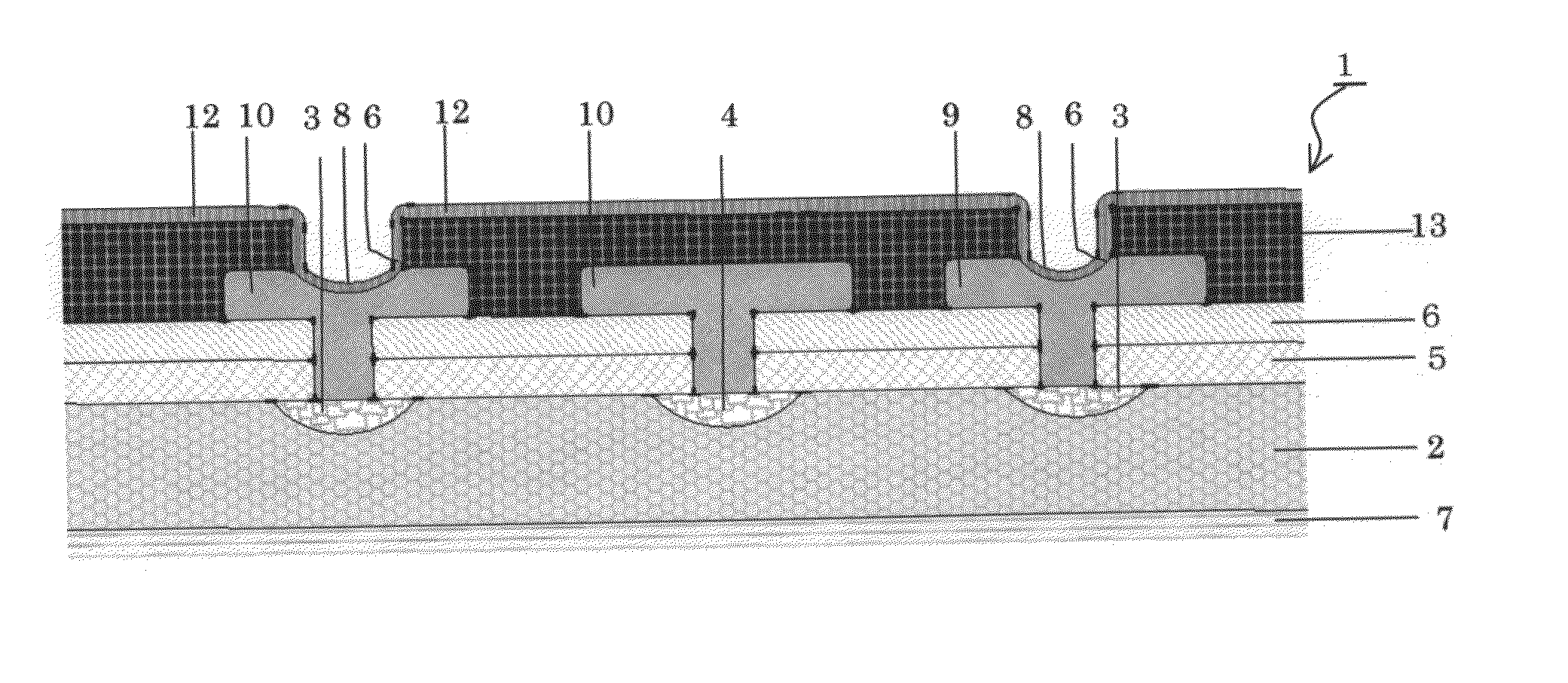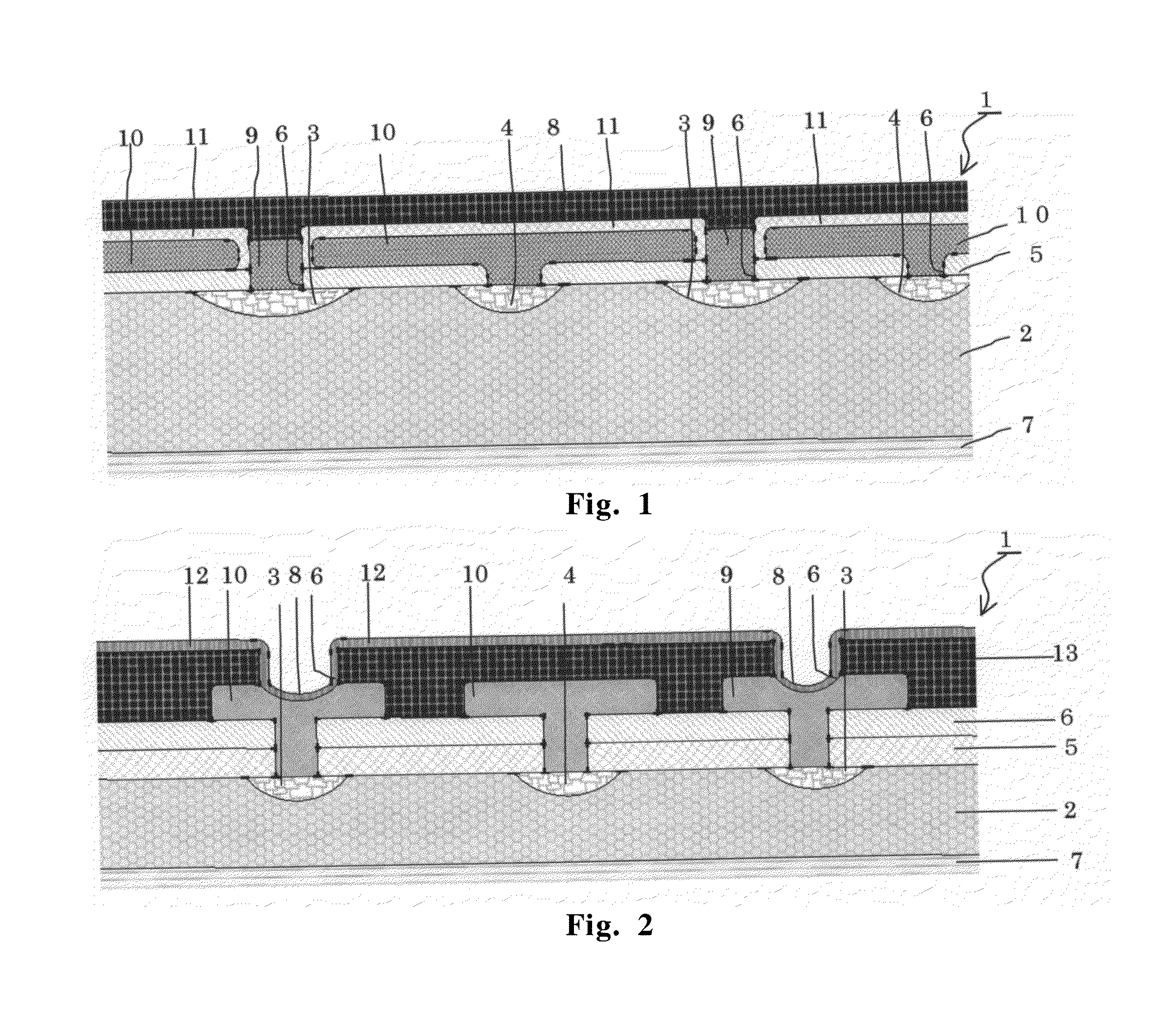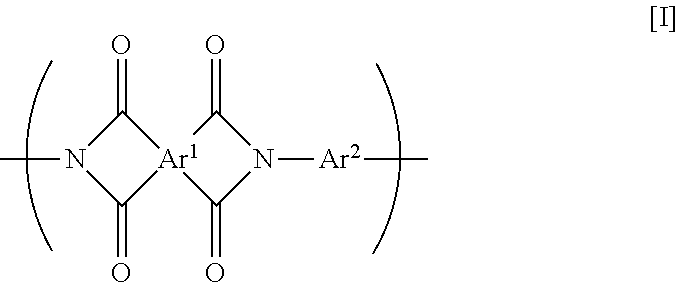Polyimide resin composition for use in forming insulation film in photovoltaic cell and method of forming insulation film in photovoltaic cell used therewith
- Summary
- Abstract
- Description
- Claims
- Application Information
AI Technical Summary
Benefits of technology
Problems solved by technology
Method used
Image
Examples
synthesis example 1
[0099]To a 2 L three-necked separable flask attached with a stainless steel anchor agitator, a ball condenser equipped with a water separation trap was attached. To the flask, 148.91 g (480 mmol) of bis-(3,4-dicarboxyphenyl)ether dianhydride (ODPA), 23.86 g (96 mmol) of 1,3-bis(3-aminopropyl)tetramethyldisiloxane (PAM-E), 70.28 g (204 mmol) of 4,4-(1,3-phenylenediisopropylidene)bisaniline (Bisaniline-M), 73.89 g (180 mmol) of 2,2-bis[4-(4-aminophenoxy)phenyl]propane (BAPP), 4.8 g of γ-valerolactone, 7.6 g of pyridine, 385 g of methyl benzoate (BAME), 385 g of tetraglyme and 100 g of toluene were added. After stirring the mixture at room temperature under a nitrogen atmosphere at 180 rpm for 30 minutes, the mixture was heated to 180° C. and stirred at this temperature for 5 hours. During the reaction, toluene-water azeotrope was removed. By removing the refluxed materials, a polyimide solution with a concentration of 28% by weight was obtained.
synthesis example 2
[0100]The same apparatus as used in Synthesis Example 1 was used. To the flask, 148.91 g (480 mmol) of ODPA, 29.82 g (120 mmol) of PAM-E, 74.41 g (216 mmol) of Bisaniline-M, 59.11 g (144 mmol) of BAPP, 4.8 g of γ-valerolactone, 7.6 g of pyridine, 303 g of ethyl benzoate (BAEE), 455 g of tetraglyme and 100 g of toluene were added. After stirring the mixture at room temperature under a nitrogen atmosphere at 180 rpm for 30 minutes, the mixture was heated to 180° C. and stirred at this temperature for 5 hours. During the reaction, toluene-water azeotrope was removed. By removing the refluxed materials, a polyimide solution with a concentration of 28% by weight was obtained
synthesis example 3
[0101]The same apparatus as used in Synthesis Example 1 was used. To the flask, 71.66 g (200 mmol) of 3,3′,4,4′-biphenylsulfone tetracarboxylic dianhydride (DSDA), 24.85 g (100 mmol) of PAM-E, 65 g of BAME, 98 g of tetraglyme, 4.0 g of γ-valerolactone, 6.3 g of pyridine and 50 g of toluene were added. After stirring the mixture at room temperature under a nitrogen atmosphere at 180 rpm for 30 minutes, the mixture was heated to 180° C. and stirred at this temperature for 1 hour. During the reaction, toluene-water azeotrope was removed. The mixture was then cooled to room temperature, and 71.66 g (200 mmol) of DSDA, 48.04 g (150 mmol) of 4,4′-diamino-2,2′-ditrifluoromethyl-1,1′-biphenyl (TFMB), 61.58 g (150 mmol) of BAPP, 130 g of BAME, 196 g of tetraglyme and 50 g of toluene were added. The mixture was allowed to react for 4 hours at 180° C. with stirring at 180 rpm. By removing the refluxed materials, a polyimide solution with a concentration of 35% by weight was obtained.
2. Prepara...
PUM
| Property | Measurement | Unit |
|---|---|---|
| Thickness | aaaaa | aaaaa |
| Viscosity | aaaaa | aaaaa |
| Frequency | aaaaa | aaaaa |
Abstract
Description
Claims
Application Information
 Login to View More
Login to View More - R&D
- Intellectual Property
- Life Sciences
- Materials
- Tech Scout
- Unparalleled Data Quality
- Higher Quality Content
- 60% Fewer Hallucinations
Browse by: Latest US Patents, China's latest patents, Technical Efficacy Thesaurus, Application Domain, Technology Topic, Popular Technical Reports.
© 2025 PatSnap. All rights reserved.Legal|Privacy policy|Modern Slavery Act Transparency Statement|Sitemap|About US| Contact US: help@patsnap.com



